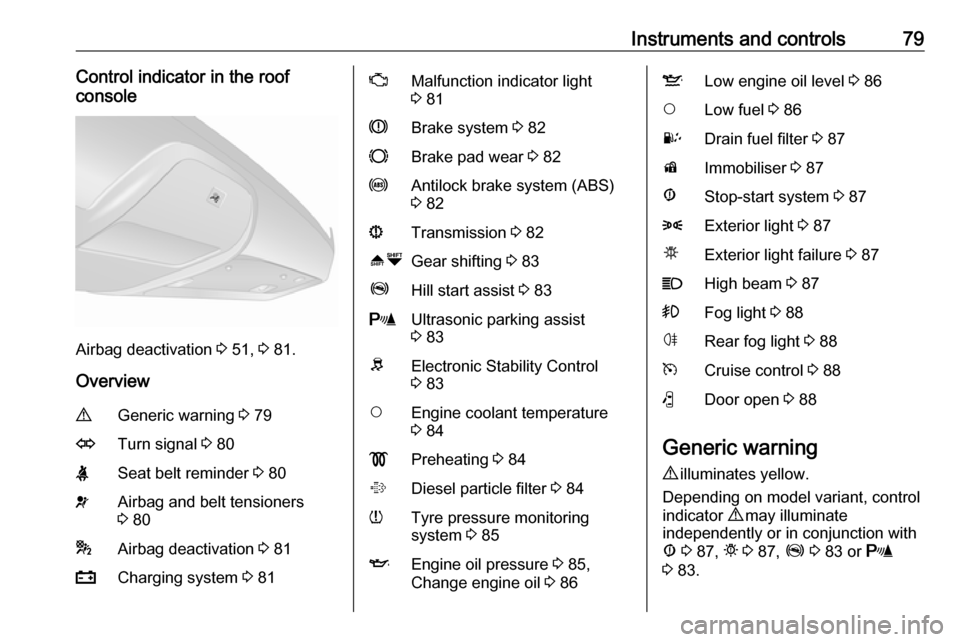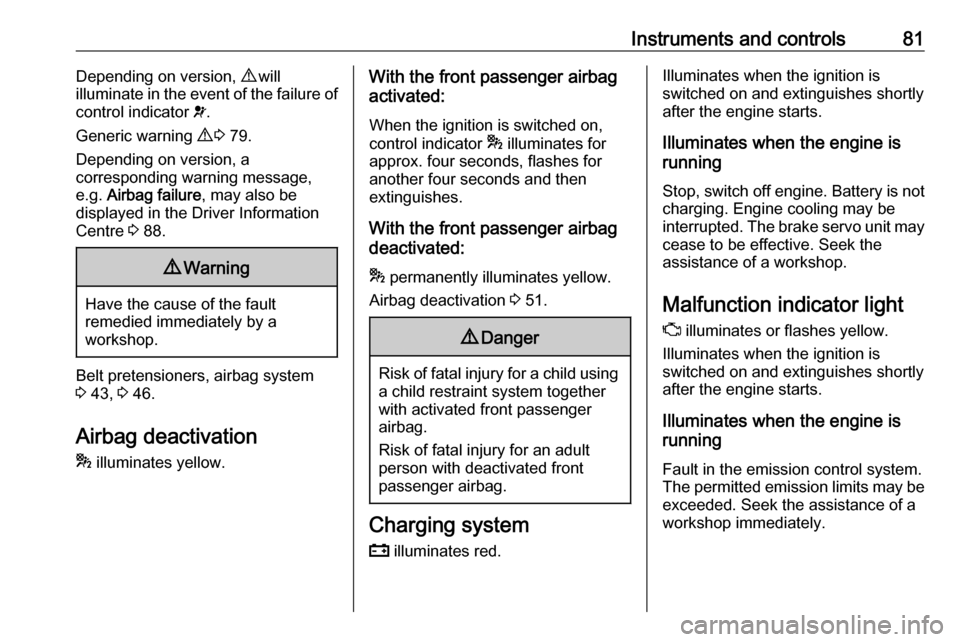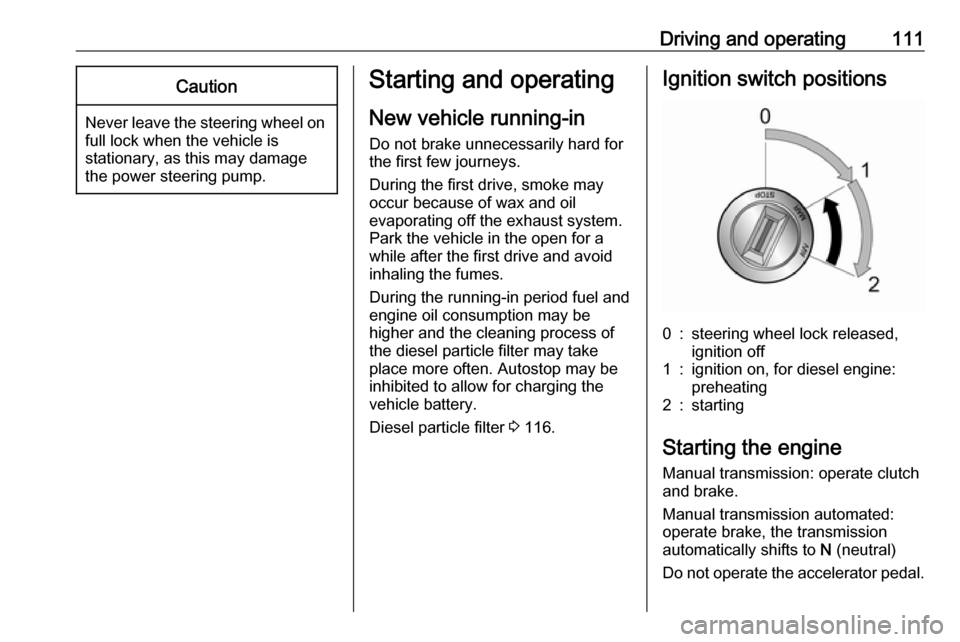charging VAUXHALL COMBO D 2017 Owner's Manual
[x] Cancel search | Manufacturer: VAUXHALL, Model Year: 2017, Model line: COMBO D, Model: VAUXHALL COMBO D 2017Pages: 195, PDF Size: 4.64 MB
Page 69 of 195

Instruments and controls67Instruments and
controlsControls ....................................... 68
Steering wheel adjustment ........68
Steering wheel controls .............68
Horn ........................................... 68
Windscreen wiper/washer .........69
Rear window wiper/washer .......69
Headlamp washer .....................70
Outside temperature ..................70
Clock ......................................... 70
Power outlets ............................. 72
Cigarette lighter ......................... 73
Ashtrays .................................... 73
Warning lights, gauges and indi‐ cators ........................................... 74
Instrument cluster ......................74
Speedometer ............................. 74
Odometer .................................. 74
Trip odometer ............................ 74
Tachometer ............................... 74
Fuel gauge ................................ 75
Fuel selector .............................. 75
Engine coolant temperature gauge ....................................... 76
Service display .......................... 76Transmission display .................77
Control indicators ......................77
Generic warning ........................79
Turn signal ................................. 80
Seat belt reminder .....................80
Airbag and belt tensioners .........80
Airbag deactivation ....................81
Charging system .......................81
Malfunction indicator light ..........81
Brake system ............................. 82
Brake pad wear ......................... 82
Antilock brake system (ABS) .....82
Transmission ............................. 82
Gear shifting .............................. 83
Hill start assist ........................... 83
Ultrasonic parking assist ...........83
Electronic Stability Control ........83
Engine coolant temperature ......84
Preheating ................................. 84
Diesel particle filter ....................84
Tyre pressure monitoring system ...................................... 85
Engine oil pressure ....................85
Change engine oil .....................86
Low engine oil level ...................86
Low fuel ..................................... 86
Drain fuel filter ........................... 87
Immobiliser ................................ 87
Stop-start system ......................87
Exterior light .............................. 87High beam................................. 87
Fog light ..................................... 88
Rear fog light ............................. 88
Cruise control ............................ 88
Door open .................................. 88
Information displays .....................88
Driver Information Centre ..........88
Vehicle messages ........................93
Warning chimes .........................93
Fuel system messages ..............94
Trip computer ............................... 94
Page 75 of 195

Instruments and controls73Caution
Do not connect any current-delivering accessories, e.g.
electrical charging devices or
batteries.
Do not damage the outlet by using unsuitable plugs.
If the tyre repair kit is in operation,
switch off all electrical consumers.
Tyre repair kit 3 159.
USB port, AUX socket
A USB port and AUX socket for the
connection of external audio sources is located at the rear of the centre
console.
Slide open cover (if fitted) to access
the socket.
Notice
The sockets must always be kept
clean and dry.
Further information is available in the
Infotainment manual.
Cigarette lighter
The cigarette lighter is located in the
centre console.
Press in cigarette lighter. It switches off automatically once the element is
glowing. Pull out lighter.
AshtraysCaution
To be used only for ash and not for combustible rubbish.
The portable ashtray should be
placed in the cupholders in the centre
console.
Page 81 of 195

Instruments and controls79Control indicator in the roof
console
Airbag deactivation 3 51, 3 81.
Overview
9Generic warning 3 79OTurn signal 3 80XSeat belt reminder 3 80vAirbag and belt tensioners
3 80*Airbag deactivation 3 81pCharging system 3 81ZMalfunction indicator light
3 81RBrake system 3 82FBrake pad wear 3 82uAntilock brake system (ABS)
3 82sTransmission 3 82[ ÒGear shifting 3 83ZHill start assist 3 83rUltrasonic parking assist
3 83RElectronic Stability Control
3 83$Engine coolant temperature
3 84!Preheating 3 84%Diesel particle filter 3 84wTyre pressure monitoring
system 3 85IEngine oil pressure 3 85,
Change engine oil 3 86SLow engine oil level 3 86$Low fuel 3 86UDrain fuel filter 3 87dImmobiliser 3 87ÆStop-start system 3 878Exterior light 3 87µExterior light failure 3 87CHigh beam 3 87>Fog light 3 88øRear fog light 3 88mCruise control 3 88(Door open 3 88
Generic warning
9 illuminates yellow.
Depending on model variant, control
indicator 9 may illuminate
independently or in conjunction with
Æ 3 87, t 3 87, Z 3 83 or r
3 83.
Page 83 of 195

Instruments and controls81Depending on version, 9 will
illuminate in the event of the failure of
control indicator v.
Generic warning 9 3 79.
Depending on version, a
corresponding warning message,
e.g. Airbag failure , may also be
displayed in the Driver Information Centre 3 88.9 Warning
Have the cause of the fault
remedied immediately by a
workshop.
Belt pretensioners, airbag system
3 43, 3 46.
Airbag deactivation
* illuminates yellow.
With the front passenger airbag
activated:
When the ignition is switched on, control indicator * illuminates for
approx. four seconds, flashes for another four seconds and then
extinguishes.
With the front passenger airbag
deactivated:
* permanently illuminates yellow.
Airbag deactivation 3 51.9 Danger
Risk of fatal injury for a child using
a child restraint system together
with activated front passenger
airbag.
Risk of fatal injury for an adult
person with deactivated front
passenger airbag.
Charging system
p illuminates red.
Illuminates when the ignition is
switched on and extinguishes shortly
after the engine starts.
Illuminates when the engine is
running
Stop, switch off engine. Battery is not
charging. Engine cooling may be
interrupted. The brake servo unit may cease to be effective. Seek the
assistance of a workshop.
Malfunction indicator light
Z illuminates or flashes yellow.
Illuminates when the ignition is
switched on and extinguishes shortly
after the engine starts.
Illuminates when the engine is
running
Fault in the emission control system.The permitted emission limits may be
exceeded. Seek the assistance of a
workshop immediately.
Page 113 of 195

Driving and operating111Caution
Never leave the steering wheel on
full lock when the vehicle is
stationary, as this may damage
the power steering pump.
Starting and operating
New vehicle running-in Do not brake unnecessarily hard for
the first few journeys.
During the first drive, smoke may
occur because of wax and oil
evaporating off the exhaust system.
Park the vehicle in the open for a
while after the first drive and avoid
inhaling the fumes.
During the running-in period fuel and
engine oil consumption may be
higher and the cleaning process of the diesel particle filter may take
place more often. Autostop may be
inhibited to allow for charging the
vehicle battery.
Diesel particle filter 3 116.Ignition switch positions0:steering wheel lock released,
ignition off1:ignition on, for diesel engine:
preheating2:starting
Starting the engine
Manual transmission: operate clutch
and brake.
Manual transmission automated: operate brake, the transmission
automatically shifts to N (neutral)
Do not operate the accelerator pedal.
Page 144 of 195

142Vehicle careBrake fluid9Warning
Brake fluid is poisonous and
corrosive. Avoid contact with eyes, skin, fabrics and painted surfaces.
The brake fluid level must be between
the MIN and MAX marks.
When topping up, ensure maximum cleanliness as contamination of the
brake fluid can lead to brake system
malfunctions. Have the cause of the
loss of brake fluid remedied by a
workshop.
Only use high-performance brake
fluid approved for the vehicle.
Brake and clutch fluid 3 173.
Vehicle battery
The vehicle battery is maintenance-
free provided that the driving profile
allows sufficient charging of the
battery. Short-distance-driving and
frequent engine starts can discharge
the vehicle battery. Avoid the use of
unnecessary electrical consumers.
Batteries do not belong in household
waste. They must be disposed of at
an appropriate recycling collection
point.
Laying up the vehicle for more than
four weeks can lead to vehicle battery
discharge. Disconnect the clamp from
the negative terminal of the vehicle
battery.
Ensure the ignition is switched off
before connecting or disconnecting
the vehicle battery.
The anti-theft alarm siren must be
deactivated as follows: Switch the
ignition on then off, disconnect the
vehicle's battery within 15 seconds.
Battery discharge protection 3 103.
Replacing the vehicle battery Notice
Any deviation from the instructions
given in this paragraph may lead to
a temporary deactivation of the stop-
start system.
In vehicles with stop-start system,
ensure the correct battery is used
when replacing the vehicle battery.
We recommend that you have the
vehicle battery replaced by a
workshop.
Stop-start system 3 113.
Page 145 of 195

Vehicle care143Charging the vehicle battery9Warning
On vehicles with stop-start
system, ensure that the charging potential does not exceed 14.6
volts when using a battery
charger. Otherwise the vehicle
battery may be damaged.
Jump starting 3 165.
Warning label
Meaning of symbols: ● No sparks, naked flames or smoking.
● Always shield eyes. Explosive gases can cause blindness or
injury.
● Keep the vehicle battery out of reach of children.
● The vehicle battery contains sulphuric acid which could cause
blindness or serious burn
injuries.
● See the Owner's Manual for further information.
● Explosive gas may be present in the vicinity of the vehicle battery.Wiper blade replacement
Lift the wiper arm until it stays in the
raised position, press button to
disengage the wiper blade and
remove.
Attach the wiper blade slightly angled
to the wiper arm and push until it
engages.
Lower wiper arm carefully.
Page 162 of 195

160Vehicle care
5. Screw the flexible filler hose ontothe tyre valve.
6. The switch on the compressor must be set to J.
7. Connect the compressor plug to the power outlet or cigarette
lighter socket.
To avoid discharging the vehicle
battery, we recommend running
the engine.8. Set the rocker switch on the compressor to I. The tyre is filled
with sealant.
9. All of the sealant is pumped into the tyre. Then the tyre is inflated.
Tyre pressure 3 185. When the
correct pressure is obtained,
switch off the compressor.
10. If a pressure of 1.5 bar is not obtained within five minutes,
remove the tyre repair kit. Move
the vehicle one tyre rotation.
Reattach the tyre repair kit and
continue the filling procedure for five minutes. If a pressure of
1.8 bar is still not obtained within
five minutes, the tyre is too badly
damaged. Seek the assistance of
a workshop.
Do not run the compressor longer
than 20 minutes.
11. Detach the tyre repair kit.
12. Remove any excess sealant using a cloth.
13. Take the label indicating maximum permitted speed from
the sealant bottle and affix in the
driver's field of view.
14. Continue driving immediately so that sealant is evenly distributedin the tyre. After driving approx.
6 miles (but no more than 10 minutes), stop and check tyre
pressure. Screw compressor air
hose directly onto tyre valve and
compressor when doing this.
Page 190 of 195

188IndexAAccessories and vehicle modifications .......................... 136
Adjustable air vents ...................108
Airbag activation ........................... 88
Airbag and belt tensioners ...........80
Airbag deactivation ..........51, 81, 88
Airbag label................................... 46 Airbag system .............................. 46
Air conditioning regular operation ................................ 109
Air conditioning system .............. 105
Air intake .................................... 109
Air vents...................................... 108
Alert .............................................. 93
Antilock brake system ................ 122
Antilock brake system (ABS) .......82
Anti-Slip Regulator (ASR) ...........124
Anti-theft locking system .............. 28
Appearance care ........................168
Armrest ......................................... 38
Ashtrays ....................................... 73 ASR (Anti-Slip Regulator) ...........124
Audible warning chimes................ 93
Autoclose ...................................... 88
Automatic fuel cut-off ............94, 112
Automatic locking .........................88
Autostop ..................................... 113
AUX socket ................................... 72B
Battery discharge protection ......103
Belts.............................................. 43
Bonnet ....................................... 138
Brake and clutch fluid .................173
Brake assist ............................... 123
Brake fluid .................................. 142 Brake pad wear ............................ 82
Brakes ............................... 122, 141
Brake system ............................... 82
Breakdown.................................. 167
Bulb replacement ....................... 144
C Capacities .................................. 184
Car Pass ...................................... 20
Catalytic converter .....................117
Central locking system ................23
Centre high-mounted brake light 148
Change engine oil .......................86
Changing tyre and wheel size ...158
Charging system .......................... 81
Child locks ................................... 24
Child restraint installation locations ................................... 54
Child restraints.............................. 53
Child restraint systems ................53
Child safety system for rear windows .................................... 30
Chimes ......................................... 93